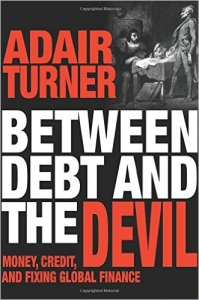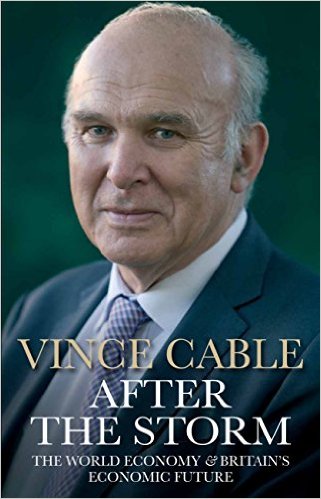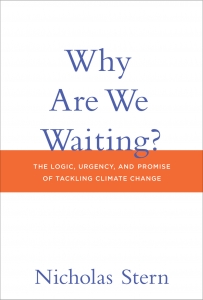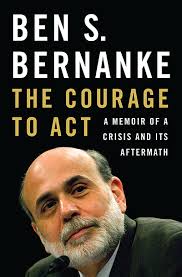Between Debt and the Devil. Adair Turner. Princeton University Press. 2015
Adair Turner shared some of his insights with LSE Business Review:
We need to address the role private debt and real estate play in our economies — Without radical reform we will be vulnerable to future crises and stuck in slow growth for many years, writes Adair Turner
Almost no economist or financial commentator saw the 2008 crisis coming: next to no one anticipated in early 2009 that recovery would prove so difficult and slow: nobody foresaw that seven years after the crisis, interest rates today would be close to zero in all major advanced economies. I became chair of the UK Financial Services Authority in September 2008, five days after Lehman Brothers collapsed, and from 2009 to 2013 I played a major role in the redesign of global financial regulation, chairing a leading policy committee of regulators and central bankers. I think we did a good job, and that the higher capital and liquidity standards we imposed will make the global financial system far more resilient. But increasingly I became convinced that our reforms failed to address the fundamentals of why 2008 occurred and why recovery has proved so difficult, and that without far more radical policy reforms we will be stuck for many years in unnecessarily slow growth, and vulnerable to future financial and economic crises.
After the Storm: The World Economy and Britain’s Economic Future. Vince Cable. Atlantic Books. 2015.
 This has been a self-congratulatory year for the British economy. On 1 January 2015, The Financial Times announced that Britain’s recovery is ‘secure’ and will ‘continue at a good pace’. There is reason for relief in Britain – unemployment is low and GDP isn’t shrinking: healthy statistics compared to many European neighbours. But the celebratory cheers are misplaced. This is the slowest recovery for a century. The unemployment numbers hide the fact that real wages are at least 8 percent lower than pre-crisis levels and per capita GDP is 16 percent lower than what we would expect from pre-crisis trends. A sunny view of the situation is that this could all turn around if the economy continues to recover at a good pace. But productivity growth – rise in output per worker – has failed to recover after the crisis. So where will the good jobs come from? Few politicians are willing to dampen the mood by bringing up the question of long-term growth. This is why Vince Cable’s After the Storm: The World Economy and Britain’s Economic Future is a book that pushes the public debate forward. It acknowledges the systemic sources of low productivity and discusses policy directions to address them.
This has been a self-congratulatory year for the British economy. On 1 January 2015, The Financial Times announced that Britain’s recovery is ‘secure’ and will ‘continue at a good pace’. There is reason for relief in Britain – unemployment is low and GDP isn’t shrinking: healthy statistics compared to many European neighbours. But the celebratory cheers are misplaced. This is the slowest recovery for a century. The unemployment numbers hide the fact that real wages are at least 8 percent lower than pre-crisis levels and per capita GDP is 16 percent lower than what we would expect from pre-crisis trends. A sunny view of the situation is that this could all turn around if the economy continues to recover at a good pace. But productivity growth – rise in output per worker – has failed to recover after the crisis. So where will the good jobs come from? Few politicians are willing to dampen the mood by bringing up the question of long-term growth. This is why Vince Cable’s After the Storm: The World Economy and Britain’s Economic Future is a book that pushes the public debate forward. It acknowledges the systemic sources of low productivity and discusses policy directions to address them.
Why Are We Waiting? The Logic, Urgency and Promise of Tackling Climate Change. Nicholas Stern. MIT Press. 2015.
 In 2006, the Stern Review was published. It fast became the most reliable and extensive analysis of the economic repercussions of climate change on human systems. To those working on climate change, Professor Lord Nicholas Stern is a familiar name. He uses the insights gained from being in positions of influence and an insider to climate change discussions – Stern is a member of the United Nations Secretary General’s High-Level Advisory Group on Climate Financing and Co-Chair of the Global Commission on the Economy and Climate – to put together a timely and definitive argument for global action on climate change.
In 2006, the Stern Review was published. It fast became the most reliable and extensive analysis of the economic repercussions of climate change on human systems. To those working on climate change, Professor Lord Nicholas Stern is a familiar name. He uses the insights gained from being in positions of influence and an insider to climate change discussions – Stern is a member of the United Nations Secretary General’s High-Level Advisory Group on Climate Financing and Co-Chair of the Global Commission on the Economy and Climate – to put together a timely and definitive argument for global action on climate change.
The Courage To Act: A Memoir of a Crisis and its Aftermath. Ben S. Bernanke. W. W. Norton and Company. 2015.
 In 1913, the United States Congress established the Federal Reserve System through the Federal Reserve Act, which was signed into law by then President Woodrow Wilson. The Act purported to provide a means of responding to different stress points in the banking sector by creating a central banking system that would pursue the interests of US citizens by seeking to ensure maximum employment and price stability for the US economy.
In 1913, the United States Congress established the Federal Reserve System through the Federal Reserve Act, which was signed into law by then President Woodrow Wilson. The Act purported to provide a means of responding to different stress points in the banking sector by creating a central banking system that would pursue the interests of US citizens by seeking to ensure maximum employment and price stability for the US economy.
The Federal Reserve Board was created to oversee the set of twelve chartered Reserve Banks that were scattered across various regions of the United States. The Board was to be made up of political appointees and situated in Washington. With the formulation of the Banking Act of 1935, Congress established seven members to serve on the Board of Governors, who would be appointed by the President of the United States and confirmed by the Senate. In October 2005, Ben S. Bernanke was nominated by President Bush to replace Alan Greenspan as chairman of the Federal Reserve. He was confirmed by the US Senate and began his chairmanship on 1 February 2006.

